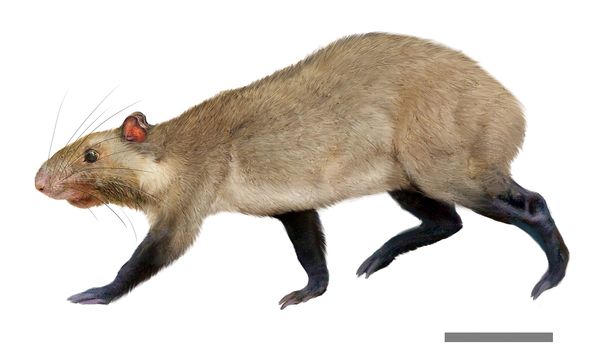Fossil Rodents With Supertough Teeth Found
Mesoprocta hypsodus, a 13-million-year-old relative of the new Chilean rodent Andemys termasi.
Two new species of fossil rodent shed light on South America as an evolutionary hot spot, a new study says. Both have supertough teeth, which suggest they may have roamed the world's earliest grassland.
Andemys termasi, nicknamed the "mouse of the Andes," would have looked like a rat and is the oldest known relative of the modern agouti, a rodent of Central and South American rain forests. The other new species, Eoviscaccia frassinettii, is the oldest known relative of the chinchilla—which it likely resembled—and vizcachas, which live in South American mountains and grasslands.
The newfound species, which lived 32 million years ago, are the second oldest ever found in South America after Peruvian mouselike and ratlike animals that date to some 41 million years ago.
The two fossils were found in an unlikely spot: central Chile's Tinguiririca River Valley (map), which is located near a chain of once active volcanoes.
For decades scientists thought fossils couldn't be found in volcanic rock, since it's usually too hot to preserve them. Somehow, though, ancient eruptions in the valley buried and preserved a fossil treasure trove.
"In this rugged terrain, the rock that accumulated from volcanic activity has preserved a record spanning 30 or 40 million years," said study co-author John Flynn, Frick Curator of Fossil Mammals at the American Museum of Natural History in New York City.
"It's one of the best archives of mammal evolution in South America."
Rodents Roamed First Grassland?
An analysis of the new species' fossilized teeth suggest that open grassland existed 15 million years before the habitat is known to have evolved on Earth.
That's because the newfound species' back, or "cheek," teeth had heavily enameled crowns that extended underneath the gums—extra reinforcement for a diet of abrasive, grassy foods, the study authors suspect.
This dental feature, known as hypsodonty, appears in other modern herbivorous mammals including horses, goats, and cows—and it's often seen as evidence that fossil animals lived in a grassy environment.
"This is a bit of a debate," Flynn said. "Some studies don't show evidence of really abundant grasses in [the region] at this time. But in the present day there's a very tight correlation between the number of species that have the hypsodonty adaptation and the occurrence of grasslands.
"So we're quite conservative, but we believe that it's likely that this represents the oldest grassland environment."
Enrique Bostelmann, of Uruguay's National Museum of Natural History, agreed that the rodents are "important, indirect support for a very early appearance of grasslands."
"But we need to be cautious, because this [adaptation] could possibly arise also from other means," said Bostelmann, who wasn't involved in the study.
For instance, some studies suggest animals have heavily enameled crowns to combat wear and tear from accidentally ingesting gritty soil. Likewise, frequent volcanism, which can make soils rougher, could be an evolutionary trigger for hypsodonty, Bostelmann said.
To confirm these prehistoric prairies, "we'd need to look at fossil pollen or other plant material to have more direct evidence of these grasslands," he added.
Ancient Rodent Explosion
Both newfound species arose during a rodent evolutionary explosion, which occurred after their ancestors had likely rafted to the continent from Africa on floating debris about 40 million years ago.
Once isolated in South America—then an island—the lineage expanded, with new species evolving to fill a multitude of ecological niches.
Eventually their ranks grew to include porcupines, guinea pigs, capybaras (picture), and other rodents.
"Today you have perhaps the richest biota in the world [in South America]," Flynn said.
"That's related to the complex interplay between the arrival of species from different places in the world, beginning probably about 40 million years ago, and then their evolution in situ there, with many different interactions between environmental, climactic, and tectonic changes."
The first rodent arrivals to the continent were likely tree-dwelling animals more adapted to life in a jungle or forest, said Bostelmann, who was part of the team that described the world's largest known rodents in southwestern Uruguay in 2008.
But the fossil record shows how these tree dwellers "start to use the environment, and finally end up with some enormous rodents."
Brian Handwerk
for National Geographic News
Published August 2, 2012












